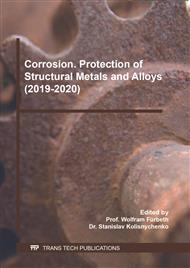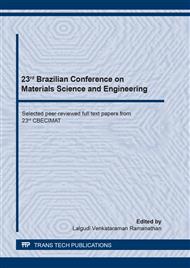p.424
p.430
p.436
p.441
p.447
p.453
p.461
p.466
p.471
The Chemical Deposition of Polypyrrole at a Copper Surface Varying Concentrations of Salicylic Acid in the Reactive Medium
Abstract:
The in situ chemical deposition of polypyrrole (Ppy) in presence of different concentrations of salicylic acid (SA) directly at copper 99.9% surface in ethanol solution using hydrogen peroxide as catalyst was studied. In all the concentrations, 50.0, 25.0, 12.5 and 6.25 mmol L-1 the polymerization was possible. The layer formed on the copper surface showed to be adherent and homogeneous. Its morphology presented as compact microspheres. The polarization curves showed a positive displacement in the corrosion potential of copper with undoped Ppy when compared to the polished copper surface. Copper surfaces containing doped Ppy-SA also showed an increase to the positive direction in the corrosion potential and the corrosion current density decreases more sharply in the presence of SA as dopant. These results indicated that Ppy+SA can act as a protective layer on copper surface and improve the corrosion protection. The protection efficiency of the coating was Cu surface < Cu+Ppy < Cu+Ppy+SA 50.0 < Cu+Ppy+SA 25.0 < Cu+Ppy+SA 12.5 < Cu+Ppy+SA 6.25 mmol L-1.
Info:
Periodical:
Pages:
447-452
Citation:
Online since:
October 2020
Authors:
Keywords:
Price:
Сopyright:
© 2020 Trans Tech Publications Ltd. All Rights Reserved
Share:
Citation:



